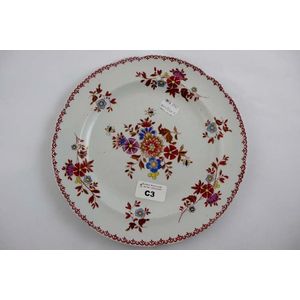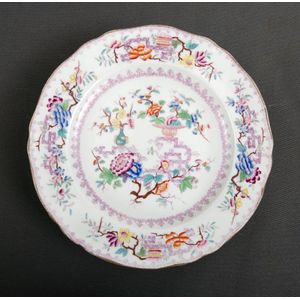Spode Cyanine Dessert Set
You must be a subscriber, and be logged in to view price and dealer details.
Subscribe Now to view actual auction price for this item
When you subscribe, you have the option of setting the currency in which to display prices to $Au, $US, $NZ or Stg.
- Willow Pattern - Although several potteries including Minton and Spode claim credit for design of the Willow pattern, the design is generally attributed to Thomas Turner of Caughley Porcelain Works in Shropshire, about 1780.
Whilst borrowing from the Chinese style, it was not a copy of a Chinese pattern.
The blue-and-white chinaware on which it appeared became immensely popular and the design was reproduced with variations by many English and European factories including Royal Worcester, Spode, Adams, Wedgwood, Davenport, Clews, Leeds and Swansea.
It was even copied in Asia, where it is still produced, with the wares being exported to Western countries.
The pattern portrays the garden of a rich mandarin whose young daughter elopes with his secretary. The lovers, overtaken on the bridge by her father, are transformed by the gods into birds and flutter beyond his reach. The scene with its willow tree usually covers the central part of a plate, dish, or bowl, with a border of butterflies, a fret, or other motif.
Traditional Willow pattern is in cobalt blue on white, though very occasionally other colours are used, such as purple or brown. The main part of the object contains the trees, houses, bridge, figures, and birds of the story and there is usually a fairly abstract pattern around the extremities. - Pearlware - Pearlware is a type of earthenware pottery that was developed in the late 18th century in England, made from a mixture of clay, flint, and other materials, and is distinguished by its smooth, creamy white glaze. The glaze has a pearlescent quality, which is how the pottery got its name.
Pearlware was developed as a more affordable alternative to porcelain, which was much more expensive and difficult to produce. It quickly became popular throughout England and Europe, and was exported to other parts of the world as well. It was particularly popular for making tableware, such as plates, bowls, and teapots, as well as decorative objects like figurines and vases.
One of the most distinctive features of pearlware is its blue decoration. Many pieces of pearlware were decorated with blue patterns or designs, often featuring pastoral scenes, floral motifs, or geometric patterns. The blue decoration was typically applied over the white glaze, which created a striking contrast and made the designs stand out.
This item has been included into following indexes:
Visually similar items

A pair of Dresden hand-painted porcelain bowls

A pair of Chamberlain Worcester meat plates, circa 1845, (2) each having a gilt highlighted rococo scroll rim, a white ground, painted with floral sprigs to the cavatto, bearing a crest to the centre with the motto ' Candidus Audaxque, (2), 41 cm wide

Antique Spode 'New Stone' plate c.1810

17 Pces Victorian Booths? porcelain Dinnerware. Chinese tree pattern, including 12 dinner plates; covered vegetable dish; two graduated platters; & circular serving plate.
